
Green Value Chain Platform English
English Learn more about impacts and adaptation in Japan's industry sectors
Learn more about impacts and adaptation in Japan's industry sectors
Learn more about impacts and adaptation in Japan's industry sectors
1. Supply chain emissions
Up to the present time, the scope of a company's emissions has been defined under various laws as the company's direct and indirect emissions,
including Scope 1 (direct emissions from the reporting company's factories, offices, vehicles, etc.)
and Scope 2 (indirect energy-derived emissions from electric power and other energy consumed by the reporting company).
However, this system has not been able to identify areas where there is room for reduction in greenhouse gas emissions in the supply chain
(such as using raw materials made with more environmentally friendly methods),
and it has not motivated companies to seek to reduce emissions by parties other than themselves.

Fig. Conceptual diagram of Scopes 1-3
Source: Based on the Corporate Value Chain (Scope 3) Accounting and Reporting Standard (2011)
Therefore, in recent years, there has been a growing move toward expanding the scope of accounting to cover emissions throughout the supply chain,
including Scope 3 (other indirect emissions), which has not been subject to accounting in the past.
This involves not only the reporting company's emissions, but also emissions upstream of the company's activities (such as raw material manufacturing)
and downstream of the company's activities (such as product sales).
When Scope 3 is included in accounting for emissions, emissions in the overall supply chain become clear,
as well as those areas of the entire supply chain where there is room to reduce emissions.
This can be expected to enable companies to take efficient measures to reduce emissions from a broader perspective, increasing their competitiveness.
By engaging the companies that make up the supply chain (including raw material manufacturers and stores) by asking them for information and so on,
it is possible to promote understanding and collaboration, advancing the reduction of greenhouse gas emissions in cooperation among related businesses.
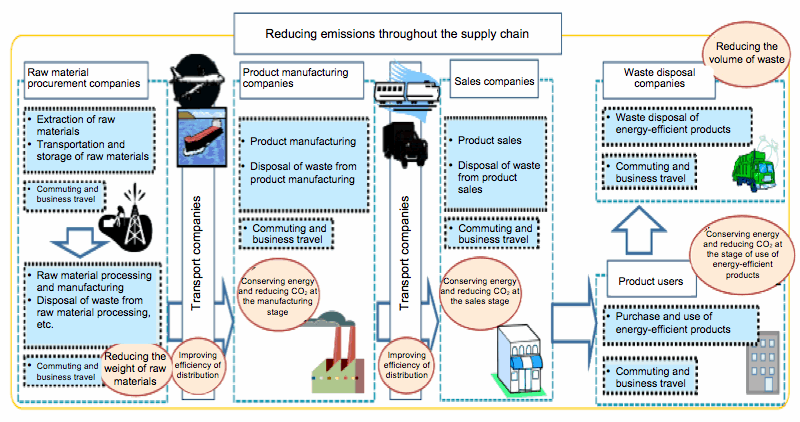
Fig. the scope of supply chain emissions and reduction of emissions
2. Domestic and international trends related to greenhouse gas emissions accounting in the supply chain
The Ministry of the Environment examined trends in supply chain emissions accounting among Japanese businesses, based on public information under the CDP.
In a survey of 500 companies around the world, including both Japanese and foreign companies, it was learned that about 80% have responded to CDP,
and more than 50% have also responded concerning Scope 3 emissions.
European and North American companies are further advanced in this area than Japanese firms.
There has been a particularly significant rise in the number of companies reporting Scope 3 emissions, compared to the increase in the number of responding companies overall.
| CDP 2010 | CDP 2011 | CDP 2012 | |
|---|---|---|---|
| Number of companies surveyed | 507 | 500 | 500 |
| Number of responding companies | 218(43%) | 215(43%) | 233(47%) |
| Number of companies responding with regard to Scope 3 | 128(25%) | 146(29%) | 172(34%) |
Among companies that responded with regard to Scope 3, only about 6% accounted for at least six categories in CDP Japan 2012, while in CDP Global 2012,
about 13% accounted for at least six categories.
This indicates that large international corporations are accounting for more categories of emissions than large Japanese corporations.
The figure below shows the results of analysis concerning the proportions of businesses accounting for each category.
The proportion of accounting in CDP Global is higher in most categories, with the exception of Category 9 (transportation and delivery, downstream).
In CDP Global, more than half of the companies accounted for Category 6 (business travel).
This seems to indicate that companies are starting by accounting for business travel, a category where accounting is easy overseas and where reductions can be achieved.
Meanwhile, it appears that a large proportion of Japanese companies are accounting for Category 9 because reporting on that portion of emissions is provided by specified consigners (shippers) under the Energy Conservation Act.
However, it is likely that shippers pay fees for transportation, and in that case, it is a value that should be reported under Category 4 (transportation and delivery, upstream).
This would result in a lower proportion accounting for Category 9 and a higher proportion accounting for Category 4.
This confusion between Categories 4 and 9 is considered to occur in CDP Global as well.
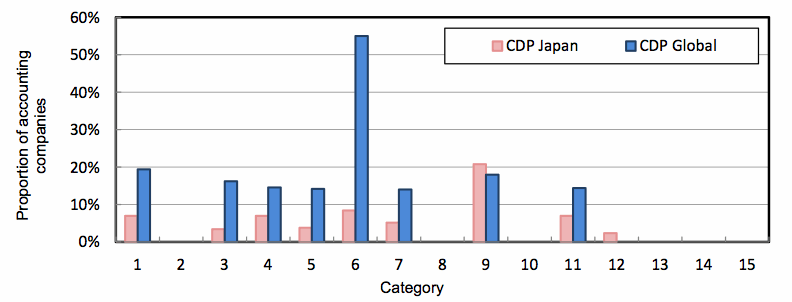
Fig. Proportion of accounting companies by category in CDP 2012
| Category 1 | Purchased goods and services |
|---|---|
| Category 2 | Capital goods |
| Category 3 | Fuel and energy related activities not included in Scope 1 or 2 |
| Category 4 | Transportation and delivery (upstream) |
| Category 5 | Waste generated in operations |
| Category 6 | Business travel |
| Category 7 | Employee commuting |
| Category 8 | Leased assets (upstream) |
| Category 9 | Transportation and delivery (downstream) |
| Category 10 | Processing of sold products |
| Category 11 | Use of sold products |
| Category 12 | End-of-life treatment of sold products |
| Category 13 | Leased assets (downstream) |
| Category 14 | Franchises |
| Category 15 | Investments |
Trends by industry
The following are the results of an analysis of the proportions of Scope 1, 2, and 3 emissions by industry, based on responses to CDP Global 2011. (Because trends cannot be determined accurately for industries with small numbers of responding companies, the analysis was limited to industries having at least 30 reporting companies.)
[1] Proportions of reporting companies by category
- The largest major category for all industries was Category 6 (business travel). Accounting in this category is progressing in every industry.
- Among other major categories, reporting on Category 1 (purchased goods and services) was more common in the mining and quarrying of stone and gravel industry; reporting on Category 4 (transportation and delivery, upstream) was more common in the manufacturing industry and wholesale and retail trade; and reporting on Category 13 (leased assets, upstream) was more common in the real estate industry and the goods rental and leasing industry.
- Among intermediate categories of manufacturing, besides Category 6 (business travel), reporting on Category 1 (purchased goods and services) was more common in the food manufacturing industry; reporting on Category 11 (use of sold products) was more common in the electrical machinery and equipment manufacturing industry and the transportation equipment manufacturing industry; and reporting on Category 4 (transportation and delivery, upstream) was widespread in many industries.
[2] Proportions of emissions by category
- Among major categories, Scope 1 and 2 emissions were higher than Scope 3 emissions in the transport and postal activities industry, the real estate industry, and the goods rental and leasing industry. In all other industries, Scope 3 emissions were higher.
- Among intermediate categories of manufacturing, in all of the industries that had at least 30 responding companies, Scope 3 emissions were higher than Scope 1 and 2 emissions.
- Among major categories as well as intermediate categories of manufacturing, emissions in Category 11 (use of sold products) accounted for a high proportion in many industries. Emissions in Category 1 (purchased goods and services) accounted for a high proportion in the wholesale and retail trade, food manufacturing, chemical and allied product manufacturing, and electrical machinery and equipment manufacturing industries. Large proportions of emissions fell under Category 10 (processing of sold products) in the non-ferrous metals and products manufacturing industry, Category 12 (end-of-life treatment of sold products) in the chemical and allied product manufacturing industry and the electrical machinery and equipment manufacturing industry, and Category 13 (leased assets, upstream) in the real estate industry and the goods rental and leasing industry.
3. Status of guideline establishment on supply chain greenhouse gas emissions accounting methods, etc.
The Sustainability Consortium
The Sustainability Consortium is an organization that was established jointly by retailers, suppliers, government agencies, universities, and NGOs in July 2009 with the goal of enabling the collection and analysis of enormous amounts of information concerning the life cycle of products worldwide. It is engaged in information gathering and analysis related to the life cycle of products. At present, approximately 80 organizations are participating, including Wal-Mart and Tesco (retail), Coca Cola (food products), Samsung (electronics), Unilever and P&G (consumer goods). From Japan, Toshiba is participating as a Tier 2 member. It is engaged in the development of a system for the measurement and reporting of sustainability related to environmental and social impacts in the life cycle of products (Sustainability Measurement and Reporting System, SMRS) and related tools.
SMRS is implemented in two stages. At Level 1, the purpose of assessment is to identify "hot spots" (areas with large social and economic impacts) in each product category. At Level 2, differences among individual products are examined, and indicators are developed to allow product comparisons.
As of March 2013, hot spot model indicators have been developed and published for 94 product categories at Level 1, and further expansion is planned in the future. At present, the time required for the process from indicator development to publication is at least one quarter, but reducing this time period will increase the speed of reaching publication. Therefore, there are plans to publish indicators for approximately 400 products by the end of 2013.
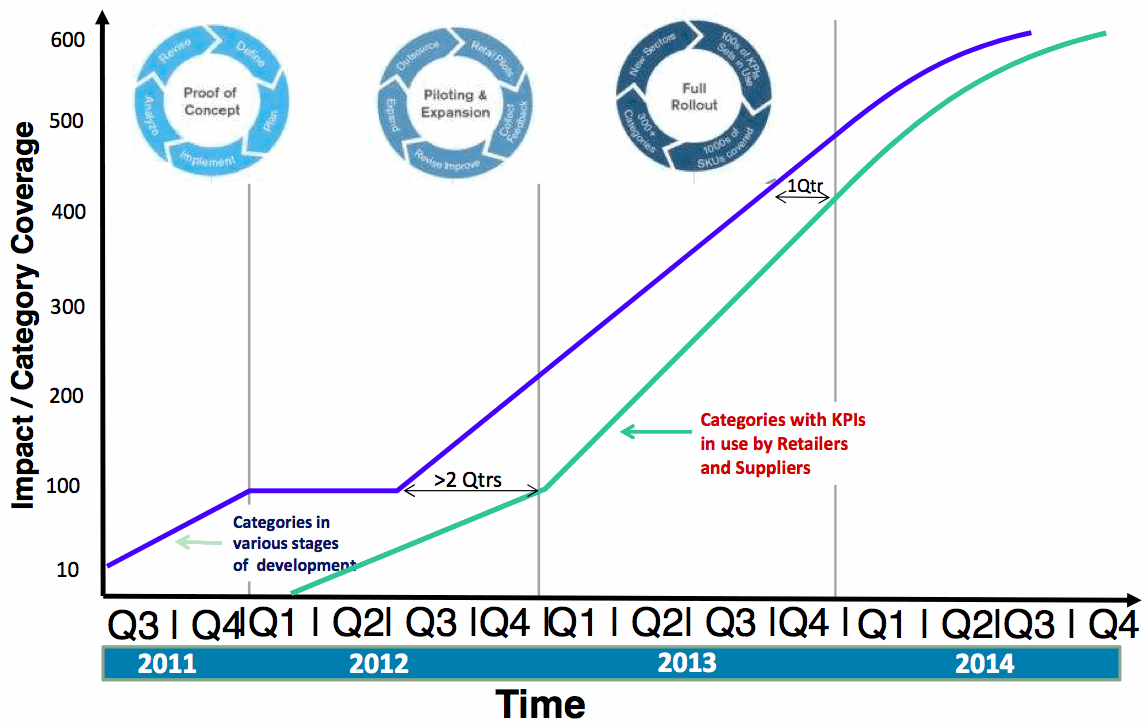
Fig. Planned expansion of the number of product categories by the Sustainability Consortium
Source: http://ec.europa.eu/agriculture/events/2012/food-sustainabilty/boone_en.pdf
Environmental footprint projects of the EC
The European Directorate-General for the Environment is working with the Joint Research Center of the European Commission to develop accounting guidelines for the environmental footprints of products. This is being developed on the basis of the International Reference Life Cycle Data System (ILCD) Handbook as well as other standards and guidance documents such as ISO 14040 to 14044, PAS 2050, BP X30, GHG Protocol Corporate Value Chain (Scope 3) Standard, the Sustainability Consortium, and ISO.
It has issued the final drafts of methodology guidance for Product Environmental Footprint (PEF) and Organisation Environmental Footprint (OEF), which include consideration for indicators other than greenhouse gases.
These guidance documents emphasize comparability of the results of accounting. Unlike the previous approach to LCA, which offered multiple options for selection of accounting conditions, these guidance documents call for alignment of accounting conditions in order to ensure the comparability of accounting results, based on the preparation of PEF category rules (PEFCR) and OEF sector rules (OEFSR), or detailed accounting rules by product category and industrial sector. There are plans for study concerning the process for preparation of PEFCRs/OEFSRs and for confirmation of the verification approach, etc.
There are 14 areas of environmental impact where assessment will be needed, including ozone depletion, toxicity, acidification, and depletion of resources, in addition to climate change. The quality of data also needs to meet certain standards. These guidance documents will have a very important influence on corporate activities, because if companies are required to disclose their footprint information, this will make product comparisons possible, allowing comparisons among products and among organizations.
Finalization of the methodology and development of related policies are planned for the first quarter of FY 2013. Drafts of the methodology for PEF and OEF were road tested in December 2011 and February 2012, and pilot testing is planned in FY 2013 in view of development of PEFCRs/OEFSRs.
This pilot testing will consist primarily of tests for the process of preparing PEFCRs/OEFSRs. Specifically, for PEFCRs, study will include the modeling of typical products, application of PEFCRs to actual products, and methods for disclosure of the environmental performance level indicated by the results of rule application. The scope of products and industries will include both intermediate materials and final products, and participants are being sought by public appeals.
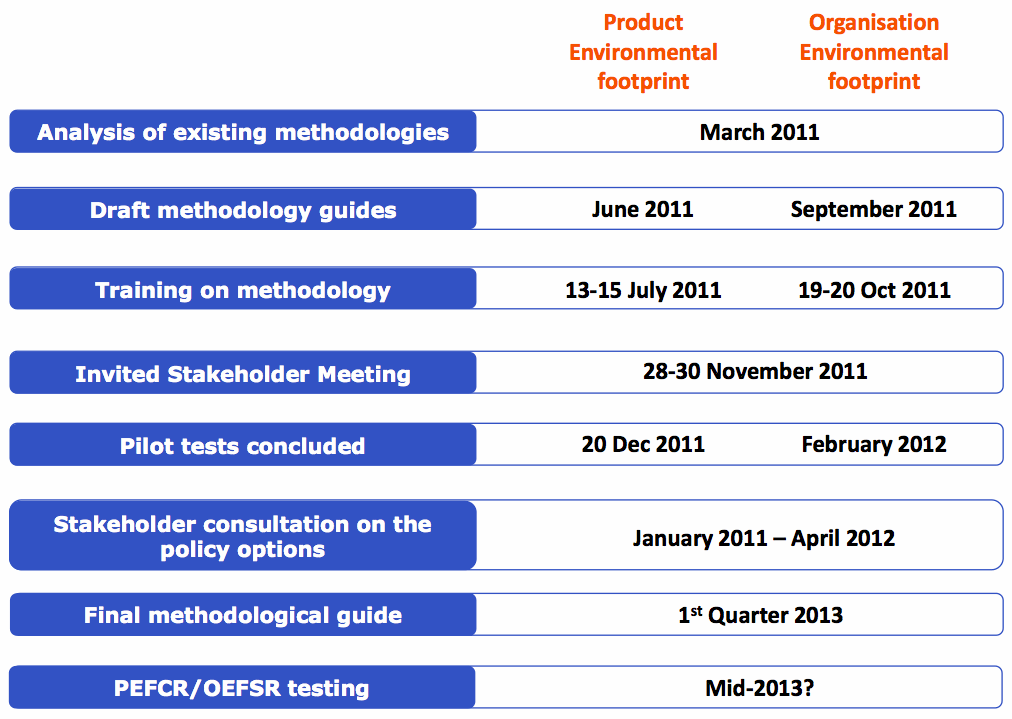
Fig. Schedule for environmental footprint projects
Source: http://www.meti.go.jp/committee/kenkyukai/sangi/lca/pdf/001_04_00e.pdf
ISO TR 14069
ISO TR 14069 (Greenhouse gases – Quantification and reporting of greenhouse gas emissions for organizations – Guidance for the application of ISO 14064-1) is a technical report which provides guidance for ISO 14064-1 (Greenhouse gases – Part 1: Specification with guidance at the organization level for quantification and reporting of greenhouse gas emissions and removals), which was standardized in 2006 by ISO TC207/SC 7. It consists of guidelines on methods for the quantification and reporting of organizational supply chain emissions (direct and indirect emissions).
In March 2006, ISO 16064 was standardized by SC 7 (Greenhouse gas management and related activities) of ISO TC207 (Technical committee for environmental management). In 2009, with the approval of a new work item proposal (NWIP) of ISO TR 14069, it was decided that a technical report would be developed to supplement its content. It was accepted with a vote on the draft technical report (DTR) in January 2012.
At the DTR stage, supply chain emissions are divided into 23 categories, and the activities covered by each category are explained.
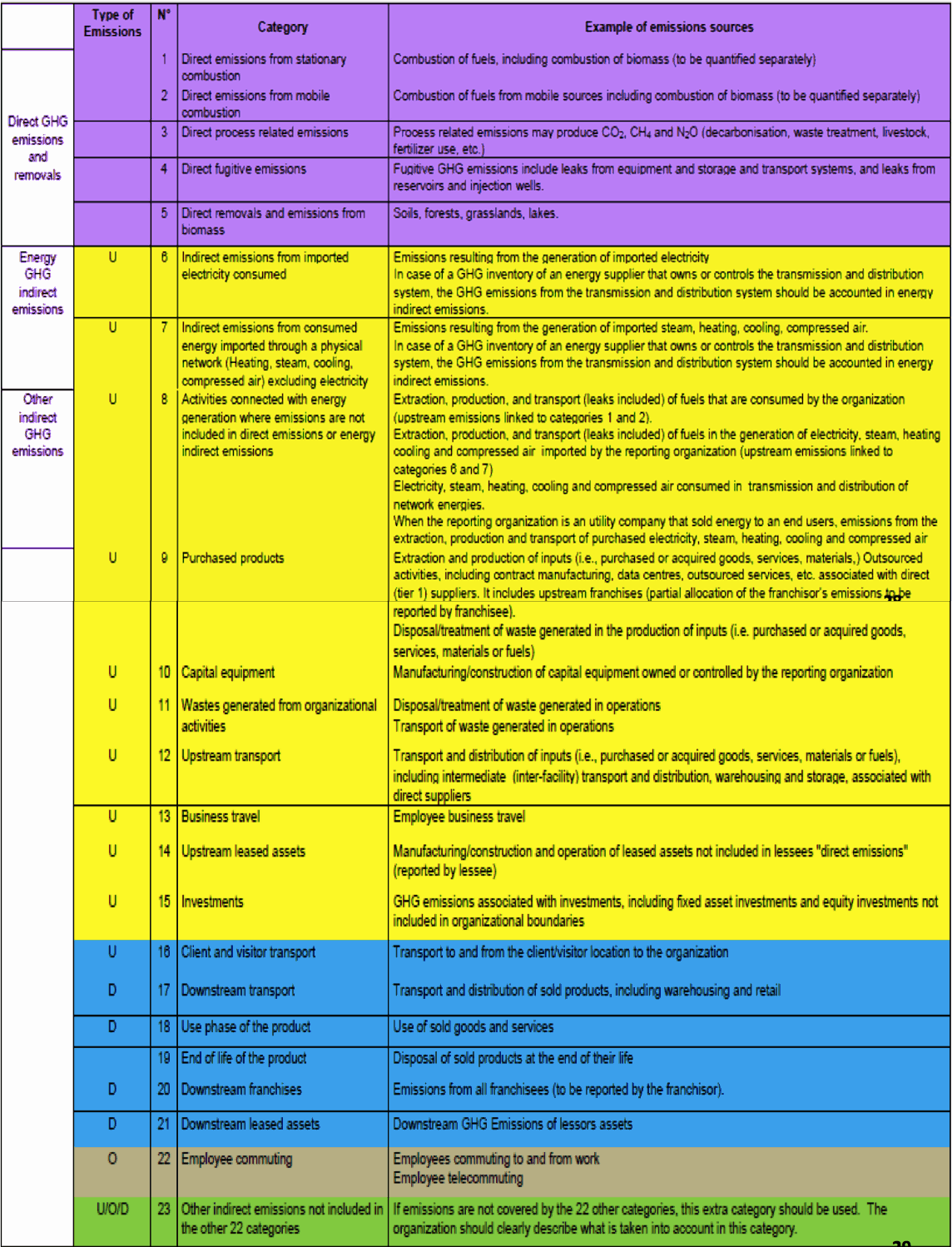
Fig. Categories in the DTR of ISO TR 14069
Source: http://www.cfp-forum.org/news/report/data/20120806_1-Inaba.pdf
As of January 24, 2013, its status is "Final Draft International Standards (FDIS) registered for formal approval."
Electric Industry Citizenship Coalition (EICC)
EICC is an electrical and electronic industry organization that was formed in 2004 by IBM, Dell, Hewlett-Packard, and other firms. As of May 2012, it has 68 member companies worldwide, most of them manufacturers of electrical and electronic devices or major suppliers.
To respond rapidly to problems that may arise in the electrical and electronic industry, such as labor safety and chemical substance management issues, the organization prepared an Electronics Industry Code of Conduct in 2004. This document provides standards for suppliers to maintain safe working environments with dignity and respect for employees, and for environmental consideration in business activities. With a changing climate for CSR, expansion has occurred in the areas that it addresses, and aspects such as carbon dioxide emissions information and the problem of conflict minerals have been added.
Concerning Scope 3 emissions, the environmental sustainability subcommittee of EICC has taken a leading role in developing the Carbon and Water Reporting Initiative (reporting on carbon dioxide emissions and water use). It implements data collection activities and provides an electronic reporting system for collection of CDP-based information on carbon dioxide emissions and water use.
In the future, EICC intends to simplify the means of reporting, including the addition of web-based data reporting. It also plans to improve the reporting methodology to deal with issues related to accounting such as the allocation of emissions.
Meanwhile, EICC also plans to provide more information to companies. It will suggest steps that a company could take to reduce its emissions, based on the data reported by that company. It is planning improvements to promote widespread use of its technology for emissions accounting, reporting, and management, including providing multilingual guidance to corporations and offering individualized guidance to suit a company's technologies.
Electronic Products Environmental Assessment Tools (EPEAT)
Electronic Products Environmental Assessment Tools (EPEAT) is a system for comprehensive assessment of the environmental impact of electronic products. It was originally based on environmental assessment standards for computers that were jointly developed by the U.S. Institute of Electrical and Electronics Engineers (IEEE) and the U.S. Environmental Protection Agency (USEPA) in March 2006. EPEAT is an indicator for use by U.S. companies, government agencies, and other organizations who wish to select environmentally friendly products when purchasing computers, and therefore, practically all companies that handle electrical and electronic devices for the U.S. market (including Japanese companies) currently engage in product LCA assessment.
EPEAT identifies 23 required criteria and 28 optional criteria of 8 fields, in line with the standards indicated in IEEE 1680. Upon applying for certification, products are rated EPEAT Gold, Silver, or Bronze. The EPEAT website states the rankings sought by private companies, as well as federal government agencies, educational institutions, state governments, and local governments. Purchasing requirements for EPEAT-qualified products are also beginning to appear in countries other than the U.S., and it is expected that sales performance will be affected in the future depending on a company's rate of acquiring the Gold rating and the quantity of a company's Gold rated products.
There are plans to revise the standards for products subject to ranking under EPEAT which have been standardized in IEEE 1680, and to expand the types of products subject to ranking (Table 2-4). At present, only two types of products are covered by standards that are available on the EPEAT website, "PC and Displays" and "Imaging Equipment." However, standards for televisions are to be published in March 2013. Standards are also being developed for servers, and there are plans to develop standards for mobile devices.
| Standard | Topic | Plans |
|---|---|---|
| IEEE 1680 | Umbrella standard for all products | To be amended |
| IEEE 1680.1 | PCs and displays | To be amended |
| IEEE 1680.2 | Imaging equipment | Completed |
| IEEE 1680.3 | Televisions | Completed |
| IEEE 1680.4 | Servers | Under development (WG convened) |
| IEEE 1680.5 | Mobile devices | Under development |
